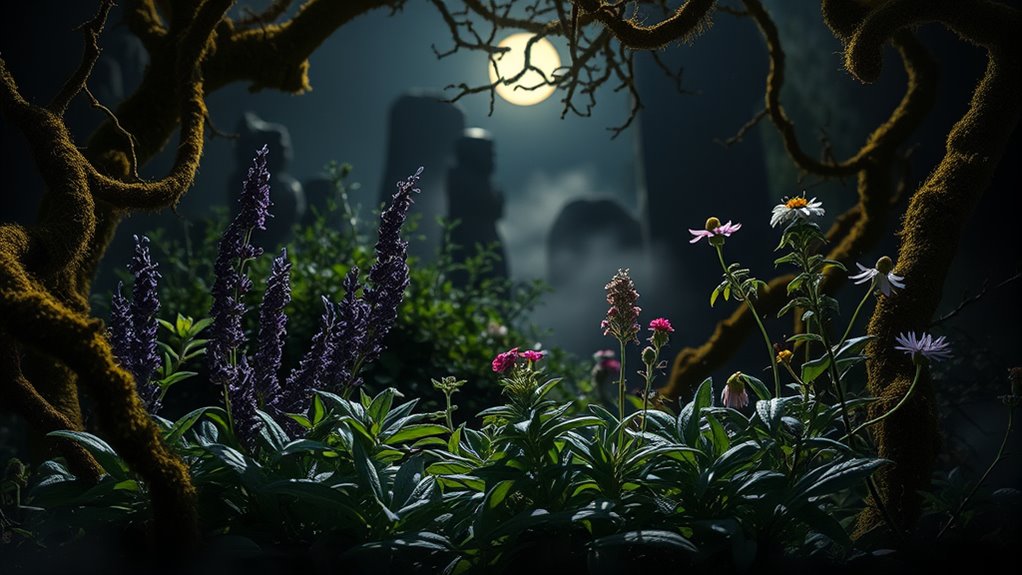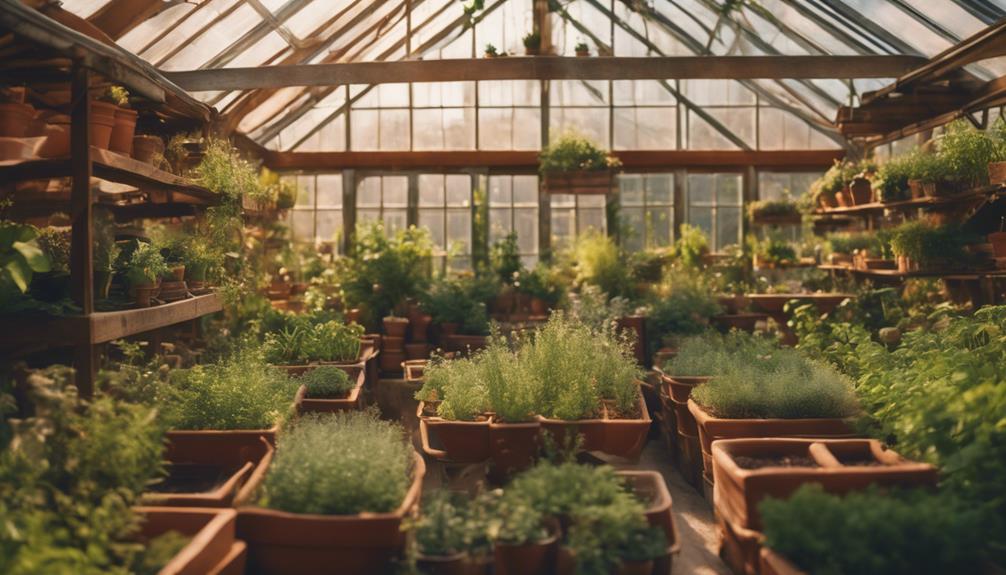A Witch’s Garden is a secret space filled with herbs that hold mystical and medicinal powers. Folklore links plants like mandrake, belladonna, lavender, and mugwort to magic, protection, and divination. While legends highlight their supernatural qualities, science reveals their true properties and risks. Whether for herbal healing or magic, each plant has its story—explore further to discover more about their fascinating history and modern use.
Key Takeaways
- Witch’s gardens historically symbolized mystical knowledge, containing rare herbs used in magic, healing, and rituals.
- Common herbs like lavender, sage, and mugwort have both medicinal and magical properties for protection, purification, and divination.
- Magical herbs such as mandrake and belladonna possess powerful, often dangerous effects, historically linked to transformation and dark magic.
- Folklore associates plants like wolfsbane with warding off evil, though scientific analysis confirms many herbs are toxic and have no mystical powers.
- Cultivating a modern witch’s garden involves selecting safe, symbolic herbs suited to the environment, focusing on practical and ritual use.
The Origins of Witch’s Gardens in Folklore
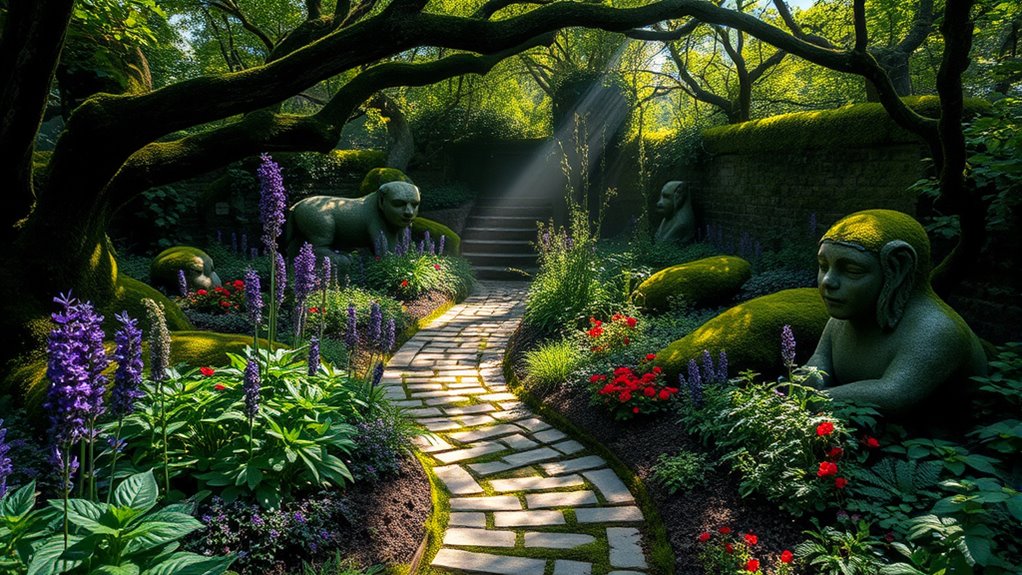
Witch’s gardens have long been rooted in folklore, serving as symbols of mystical knowledge and hidden power. Historically, these gardens appeared in stories and legends as secret places where witches cultivated rare herbs and mystical plants. People believed that witches possessed special knowledge of herbs’ magical properties, often kept hidden from others. In medieval times, these gardens became associated with suspicion and fear, fueling accusations of witchcraft. Folklore suggests that witches created these secret gardens to access supernatural powers, cure ailments, or cast spells. Over time, the idea of a witch’s garden grew into a symbol of mystery, blending real herbal knowledge with myth. These gardens became legendary spaces, embodying both fear and fascination with the unseen forces of nature.
Common Herbs Found in Historic Witch’s Gardens

Many herbs you might recognize today played important roles in historic witch’s gardens. These plants weren’t just for medicine; they also held ritual and spell significance. Exploring their uses reveals the deep connection between herbs, healing, and magic.
Popular Medicinal Herbs
Popular medicinal herbs often grow at the heart of historic witch’s gardens, serving as essential tools for healing and ritual. You’ll find herbs like chamomile, known for calming nerves and easing sleep, and lavender, prized for its antiseptic and relaxing properties. Echinacea is valued for boosting immunity, while peppermint provides relief from digestive issues. Sage, another common herb, is used for its antimicrobial qualities and to purify spaces. Yarrow has long been used to stop bleeding and promote healing, and calendula brightens gardens with its skin-soothing properties. These herbs aren’t just decorative—they’re practical, with specific uses rooted in centuries of traditional medicine. Their presence in historic gardens reflects a deep understanding of natural remedies and the importance of medicinal plants in everyday life.
Ritual and Spell Uses
Herbs cultivated in historic witch’s gardens weren’t just for healing—they also played an essential role in rituals and spells. You might use these herbs to attract love, banish negativity, or enhance psychic abilities. For example, basil is often used in love spells, while mugwort helps with divination. The power of these herbs depends on their symbolism and the intent behind their use. To highlight this, consider the table below:
| Herb | Ritual Use | Symbolism |
|---|---|---|
| Lavender | Cleansing and protection | Peace and tranquility |
| Rosemary | Memory enhancement and purification | Remembrance |
| Sage | Smudging and purification | Wisdom and clarity |
| Mugwort | Dream work and divination | Intuition |
Using herbs in spells aligns your intentions with their energetic properties.
The Magical Properties Attributed to Mandrake Root
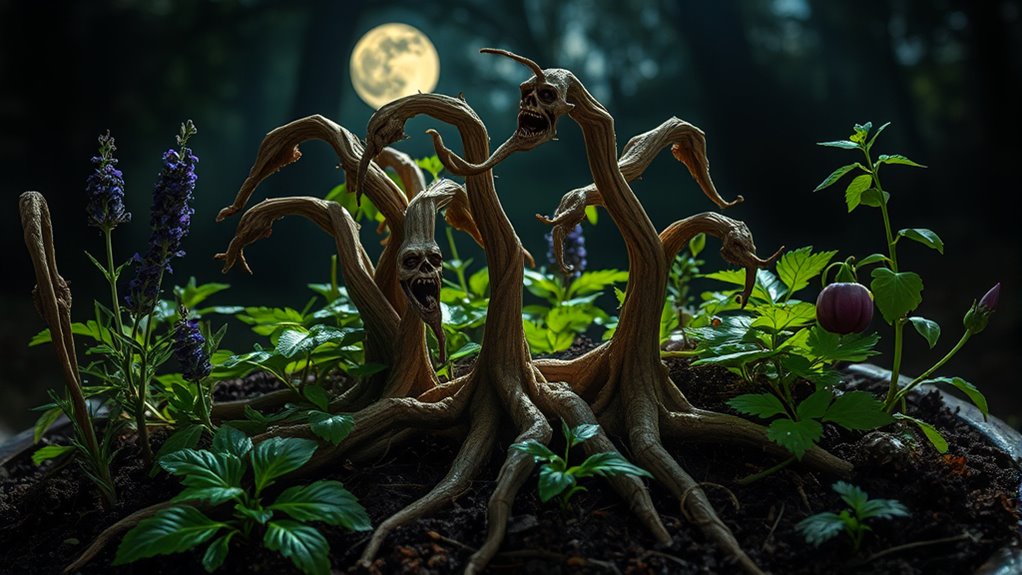
Mandrake root has long been believed to cause vivid hallucinations, which many think enhance magical work or rituals. It’s also thought to serve as a powerful protective talisman against evil spirits and negative energies. Additionally, historically, people used mandrake in medicine, trusting its supposed healing properties for various ailments.
Hallucinogenic Effects
Many believe that the mandrake root possesses powerful hallucinogenic properties, capable of inducing vivid and otherworldly visions. In folklore, those who consume or come into contact with it often report experiencing intense, dream-like states that blur reality. Some say it can transport you to mystical domains or reveal hidden truths. Historically, practitioners used the root in rituals to induce altered consciousness, believing it opened gateways to spiritual insight. The effects are thought to be unpredictable, varying from person to person, and sometimes accompanied by disorientation or nausea. Despite its reputation, these hallucinations are often linked to the toxic nature of the plant, making it dangerous if misused. Its hallucinogenic qualities contribute to its mystique in magical traditions and legends.
Protective Talismans
Because of its powerful associations, the mandrake root has long been used as a protective talisman in magical traditions. You might carry or place it in your home to ward off evil spirits and negative energies. Its roots are believed to act as a barrier against harm, making it a popular choice for safeguarding loved ones. When used as a talisman, the mandrake is often inscribed with symbols or carried in a cloth pouch. Its potent energy is thought to repel malevolent influences and protect against curses. Incorporate it into your spiritual practice by placing it near entrances or wearing it as a pendant. Its reputation as a powerful protective charm endures, rooted in folklore and ancient magic.
Medicinal Uses
With its storied history in herbal magic, mandrake root has long been prized for its supposed medicinal properties. Ancient healers believed it could treat a variety of ailments, from pain relief to insomnia. You might have heard that mandrake was used as an anesthetic during surgical procedures, thanks to its potent psychoactive effects. Some thought it could dispel evil spirits and ward off curses, making it a protective charm as well as a remedy. However, caution is essential because mandrake is highly toxic if misused. Its alkaloids can cause hallucinations, convulsions, or even death. Despite its dangerous reputation, it’s clear that in folklore, mandrake’s magical and medicinal qualities are deeply intertwined, symbolizing both healing power and peril.
Witches and the Use of Belladonna in Potions
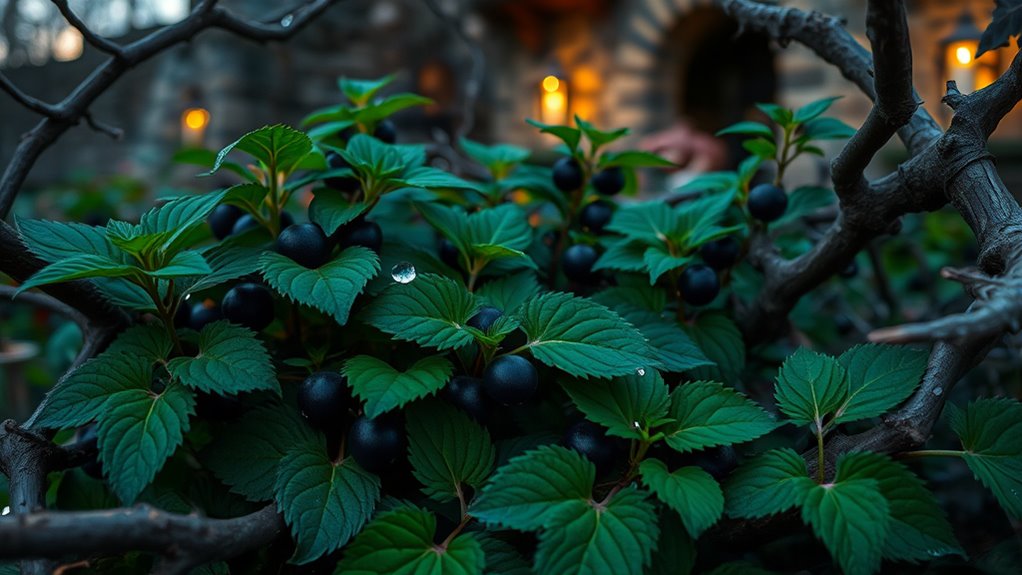
Have you ever wondered why witches historically prized belladonna in their potion-making? This deadly plant, known for its powerful effects, was believed to hold mystical properties. Witches used belladonna to cast spells, create poisons, and induce visions. Its toxic qualities made it a potent ingredient, but also dangerous to handle. When working with belladonna, witches often:
- Carefully measured doses to avoid lethal outcomes
- Combined it with other herbs to amplify its effects
- Used it in rituals to induce altered states of consciousness
Despite its peril, belladonna’s allure persisted in folklore as a symbol of dark magic and transformation. Witches understood its power and respected its risks, harnessing its properties for both healing and harm.
Lavender: From Sacred Plant to Healing Herb
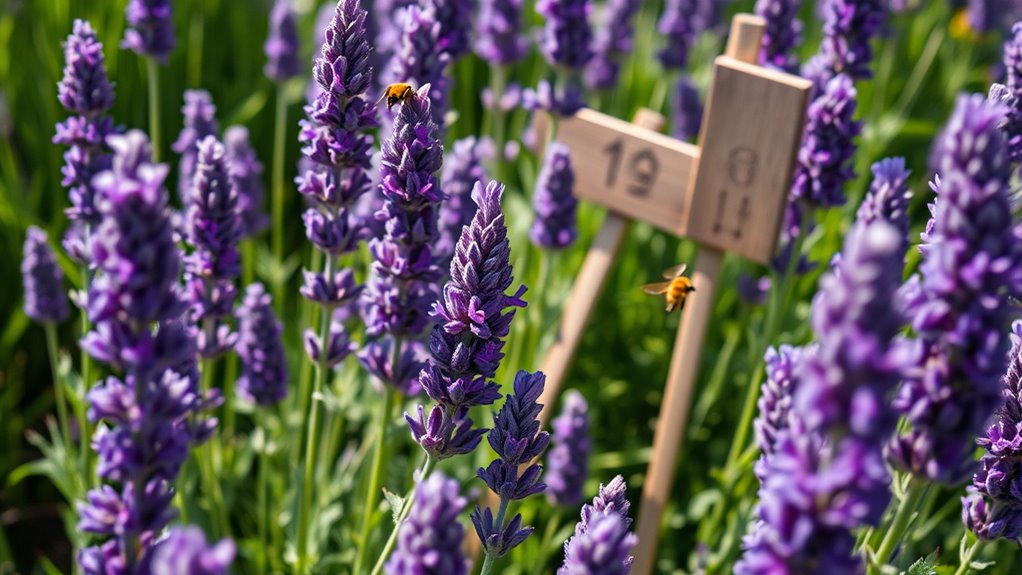
Although lavender is now widely known for its calming scent, it once held deep spiritual significance in ancient cultures. People believed it had protective and purifying powers, often using it in rituals to ward off evil spirits and negative energies. Its fragrant blooms were burned or sprinkled during ceremonies to invite peace and spiritual clarity. Lavender was also associated with love and devotion, symbolizing purity and grace. Throughout history, it’s been valued not only for its pleasant aroma but for its healing properties. Today, you’ll find lavender in teas, oils, and herbal remedies, still carrying its reputation as a soothing, restorative herb. Its long-standing connection to spirituality and healing makes it a cherished plant in both traditional and modern herbal practices.
The Role of Mugwort in Divination and Dream Work
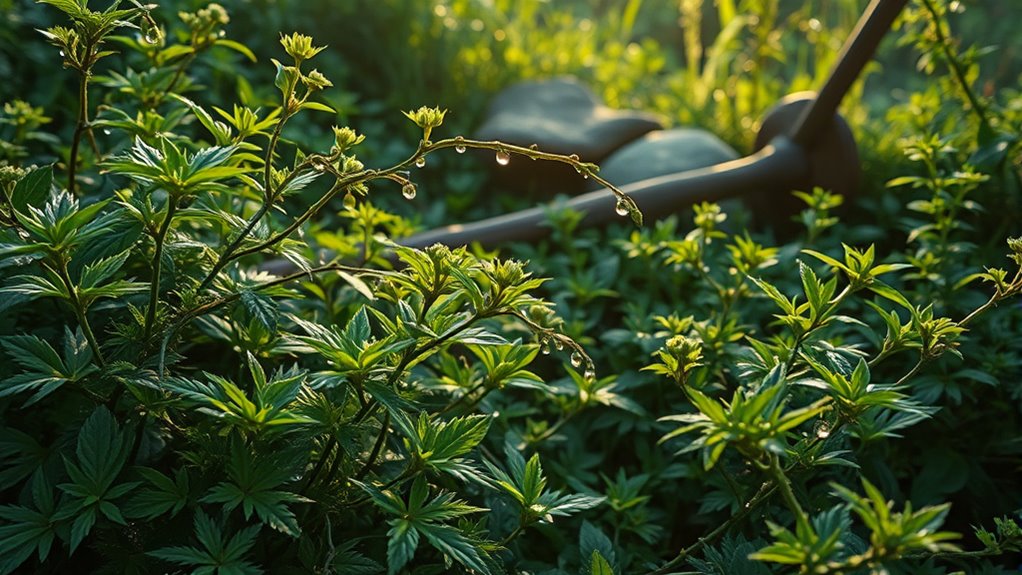
Mugwort has long been prized for its ability to enhance dreams and open hidden insights. People use it in various divination practices, often incorporating specific preparations and rituals to focus their intentions. Exploring these methods reveals how mugwort’s powers can deepen your connection to the unseen domain.
Mugwort’s Dream Enhancing Powers
Many practitioners turn to mugwort when seeking clearer insights from their dreams and divination practices. Its reputation as a dream enhancer is well-earned, helping you remember details more vividly and interpret symbols more accurately. To maximize its powers, you might:
- Place dried mugwort under your pillow before sleep
- Brew it into a tea to promote lucid dreaming
- Use it in smudging rituals to clear mental fog
These methods can deepen your connection to the subconscious and make your dreams more meaningful. Mugwort’s influence extends beyond simple recall; it encourages intuitive insights and symbolic understanding. Consistently working with mugwort can sharpen your divinatory skills and unveil hidden messages from your dreams. Its subtle, potent energy supports your journey into the subconscious domain.
Traditional Divination Uses
Throughout history, practitioners have relied on mugwort as a powerful tool for divination and spiritual insight. You might have used it to enhance your intuition or to connect with spirits during rituals. Mugwort’s reputation for revealing hidden truths comes from its ability to open the third eye and amplify your psychic senses. People often placed dried mugwort under pillows or burned it as an incense before seeking answers through dreams or visions. Some believed that carrying a sprig of mugwort could help interpret signs and symbols seen in dreams or during meditation. Its connection to the spirit world made it a key ingredient in many divination practices. By working with mugwort, you tap into its natural ability to deepen your intuitive understanding and uncover what lies beyond the physical sphere.
Preparation and Rituals
To effectively harness mugwort for divination and dream work, you should prepare your space and intentions carefully. Begin by cleansing your area—use sage or other purifying methods to clear negative energies. Set a clear intention for your ritual, focusing on the insights or dreams you seek. Next, create a calming environment with soft lighting, calming music, or incense. When ready, consider these steps:
- Place dried mugwort leaves or a bundle under your pillow or in a dream pouch.
- Meditate beforehand to center your mind and focus your energy.
- Keep a journal nearby to record visions or dreams upon waking.
Recognizing Herbs With Historical Medicinal Uses
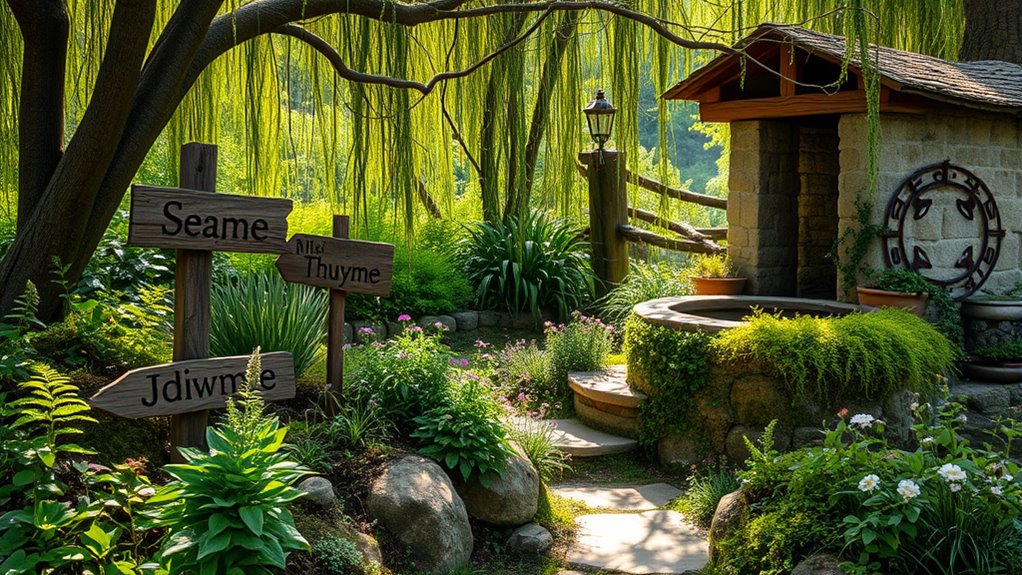
You can identify herbs with historical medicinal uses by paying attention to their distinctive smells, shapes, and growth patterns. For example, basil’s sweet aroma and oval leaves have made it a staple in traditional remedies. Lavender’s fragrant scent and slender purple spikes signal its calming properties. Echinacea features spiky, daisy-like flowers that were used to boost immunity. Mint’s sharp, invigorating smell and jagged leaves indicate its role in digestive aid. Observe their growth habits—some herbs thrive in sunny patches, others prefer shaded areas. Recognizing these physical traits helps connect you to their past uses in healing practices. Familiarity with these characteristics allows you to identify herbs rooted in medicinal traditions, enriching your understanding of their historical significance and potential contemporary benefits.
Myths and Legends Surrounding Wolfsbane and Its Dangers
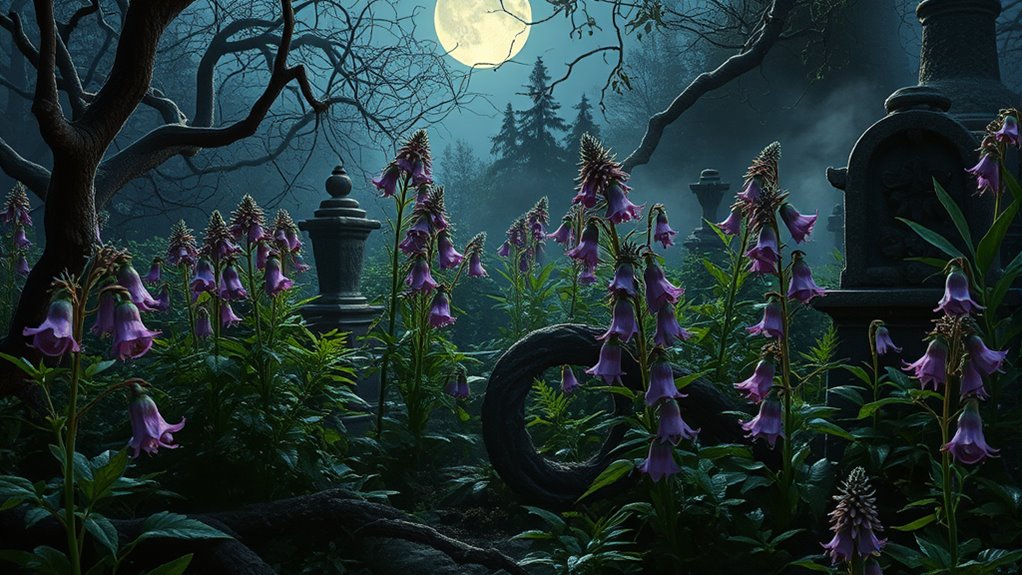
Wolfsbane, also known as aconite, has long been shrouded in myth and legend, often portrayed as a deadly plant with mystical powers. Stories warn that a single touch or ingestion can cause death, fueling fears and superstitions. Folklore suggests it can ward off or harm werewolves, leading to its reputation as a dangerous protector. You might have heard that:
- It can instantly kill anyone who touches it.
- It has the power to ward off evil spirits.
- Its fumes can cause madness or death from a distance.
While these legends heighten its mystique, they also create misconceptions about its true dangers. In reality, wolfsbane is highly toxic, but its effects depend on dosage and exposure. Its reputation remains rooted in folklore, not factual danger.
Modern Botanical Science and the Truth Behind Magical Claims
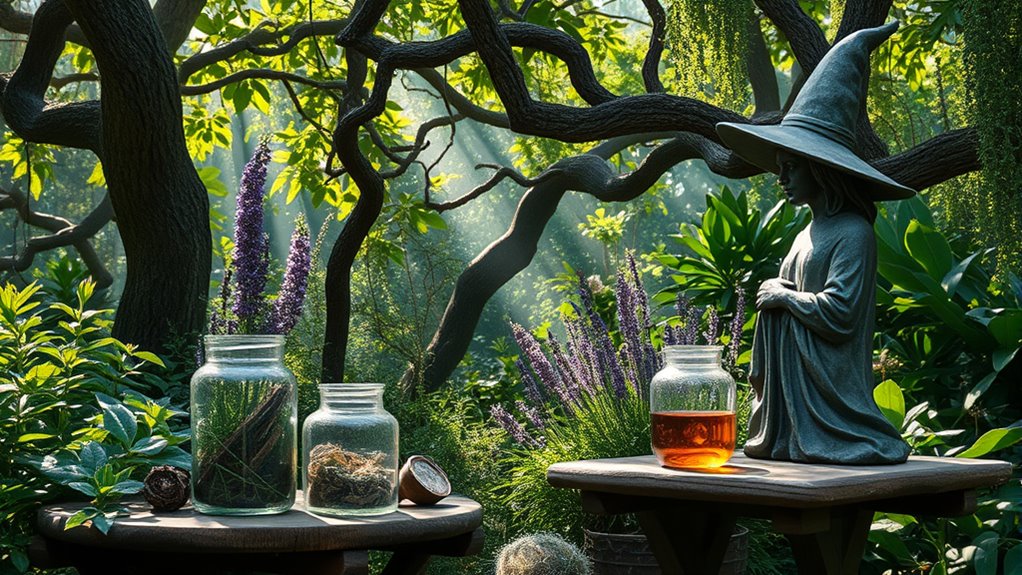
Modern botanical science has begun to separate fact from fiction, revealing the true nature of plants like wolfsbane. Researchers analyze plant compounds to understand their real effects and potential risks, debunking exaggerated claims. For example, while wolfsbane contains toxic alkaloids, it doesn’t possess the magical powers often attributed to it in folklore. Scientific studies show that many herbs once thought to have mystical properties are simply plants with specific chemical properties that can be harmful if misused. This progress helps demystify these herbs, emphasizing their biological roles rather than mystical attributes. You learn to approach herbal lore critically, recognizing that science can clarify misconceptions and highlight the true potential — or danger — of these plants, grounding your understanding in evidence rather than superstition.
Cultivating a Contemporary Witch’s Garden
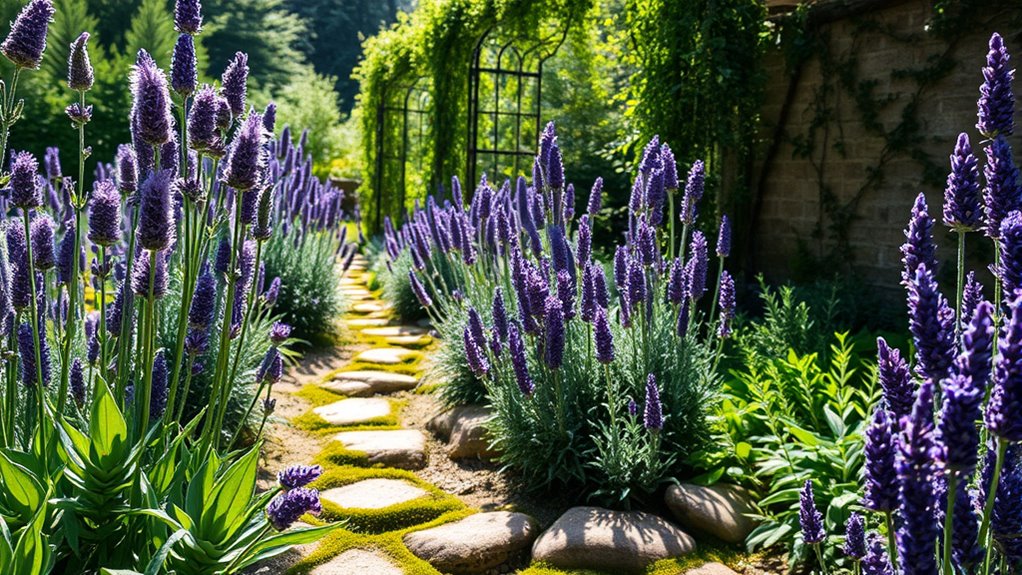
Creating a contemporary witch’s garden involves selecting plants that balance symbolism, practicality, and safety. You want herbs and flowers that inspire your craft while being easy to grow and non-toxic. Focus on plants like sage, lavender, and thyme for their versatile uses, both magical and culinary. Consider safety by avoiding highly toxic plants like belladonna or deadly nightshade. To succeed, keep these points in mind:
Create a safe, inspiring witch’s garden with versatile, non-toxic herbs like sage, lavender, and thyme.
- Choose plants suited to your climate and soil conditions
- Incorporate herbs with personal or traditional significance
- Maintain regular care to promote healthy growth and strong energy
Frequently Asked Questions
Are All Herbs in Witch’s Gardens Actually Magical?
No, not all herbs in witch’s gardens are actually magical. Many herbs have real medicinal or culinary uses, but their associations with magic come from folklore and tradition. You might find herbs like lavender or sage, which are believed to have protective or healing properties, but their true power lies in their practical benefits. So, while some herbs hold symbolic magic, others are simply useful plants with no mystical properties.
Can Anyone Cultivate a Witch’s Garden Today Legally?
Yes, you can legally cultivate a witch’s garden today. There’s no law prohibiting growing herbs or plants associated with folklore and magic. You might want to check local regulations if you’re planning to sell or use certain herbs commercially, but generally, planting and nurturing a garden of traditional herbs is perfectly legal. Just guarantee you’re respecting property boundaries and local ordinances, and enjoy exploring your botanical interests.
What Are the Real Health Benefits of Traditional Magical Herbs?
You’ll be amazed to find that traditional magical herbs aren’t just for spells—they’ve got real health perks too. Think chamomile calming your nerves, peppermint easing digestion, or lavender promoting relaxation. While some claims are fanciful, many herbs contain antioxidants and anti-inflammatory compounds backed by science. So, next time you pluck a sprig, remember: these plants might just help you feel better—no magic wand required.
How Do Modern Witches Incorporate Herbs Into Their Practices?
You incorporate herbs into your practices by using them in spells, rituals, and everyday offerings. You might create herbal sachets, infuse oils, or brew teas for specific intentions. You also use fresh or dried herbs to cleanse spaces or enhance meditation. By connecting with their energies and properties, you personalize your practice, blending tradition with intuition to strengthen your magical work.
Are There Safety Concerns With Growing or Using These Herbs?
You should always be cautious when growing or using magical herbs, as some can cause allergic reactions or toxicity if misused. Coincidentally, many herbs like belladonna and deadly nightshade are beautiful but dangerous. Always research each herb thoroughly, wear gloves when handling, and consult reliable sources or professionals if you’re unsure. Safety first guarantees your practice remains both magical and risk-free.
Conclusion
As you delve into the world of magical herbs, remember that history and myth often walk hand in hand. While some plants hold real medicinal value, others are shrouded in legend, like whispers in the wind. Keep your curiosity alive, but stay grounded in fact. After all, it’s true that you can’t judge a book by its cover—so explore your garden with an open mind and an eye for the truth.

